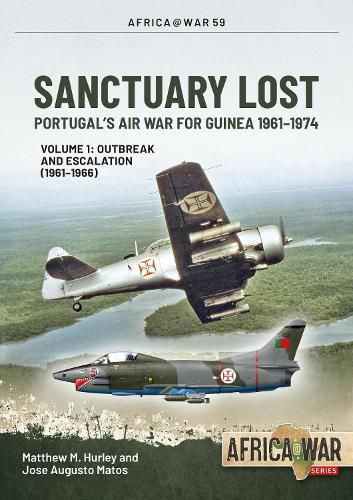Readings Newsletter
Become a Readings Member to make your shopping experience even easier.
Sign in or sign up for free!
You’re not far away from qualifying for FREE standard shipping within Australia
You’ve qualified for FREE standard shipping within Australia
The cart is loading…






From 1963 to 1974, Portugal and its nationalist enemies fought an increasingly intense war for the independence of Portuguese Guinea, then a colony but now the Republic of Guinea-Bissau. For most of the conflict, Portugal enjoyed virtually unchallenged air supremacy, and increasingly based its strategy on this advantage. The Portuguese Air Force (Forca Aerea Portuguesa, abbreviated FAP) consequently played a crucial role in the Guinean war. Indeed, throughout the conflict, the FAP
despite the many challenges it faced
proved to be the most effective and responsive military argument against the PAIGC, which was fighting for Guinea’s independence. The air war for Guinea is unique for historians and analysts for several reasons. It was the first conflict in which a non-state irregular force deployed defensive missiles against an organized air force. Moreover, the degree to which Portugal relied on its air power was such that its effective neutralization doomed Lisbon’s military strategy in the province. The FAP’s unexpected combat losses initiated a cascade of effects that degraded in turn its own operational freedom and the effectiveness of the increasingly air-dependent surface forces, which felt that the war against the PAIGC was lost. The air war for Guinea thus represents a compelling illustration of the value
and vulnerabilities
of air power in a counter-insurgency context, as well as the negative impacts of overreliance on air supremacy.A detailed, blow-by-blow account on the operational history of Portuguese air power during the Colonial War in Guine (Guinea) of the 1960s and the 1970s, and of the guerrillas’ reaction
by establishing organised and coordinated air defenses
to the complete enemy aerial superiority. AUTHORS: Matthew M. Hurley is a military historian (PhD, The Ohio State University, 2009) and retired US Air Force colonel (US Air Force Academy, 1990). His 24-year military career included intelligence assignments worldwide, as well as instructor tours at the NATO Tactical Leadership Programme and USAF Air Command and Staff College. He has published and presented numerous works regarding military and air power history, operational design, and intelligence matters, most recently with the Mitchell Institute for Aerospace Studies. Jose Matos is an independent researcher in military history in Portugal with a primary interest in operations of the Portuguese Air Force during the colonial wars in Africa, especially in Guinea. He is a regular contributor to numerous European magazines on military aviation and naval subjects, and has collaborated in the major project ‘The Air Force at the end of the Empire’, published in Portugal in 2018. This is his first instalment for Helion. 72 photos, 5 colour photos, 15 colour profiles, 16 maps, 2 diagrams, 23 tables
$9.00 standard shipping within Australia
FREE standard shipping within Australia for orders over $100.00
Express & International shipping calculated at checkout
From 1963 to 1974, Portugal and its nationalist enemies fought an increasingly intense war for the independence of Portuguese Guinea, then a colony but now the Republic of Guinea-Bissau. For most of the conflict, Portugal enjoyed virtually unchallenged air supremacy, and increasingly based its strategy on this advantage. The Portuguese Air Force (Forca Aerea Portuguesa, abbreviated FAP) consequently played a crucial role in the Guinean war. Indeed, throughout the conflict, the FAP
despite the many challenges it faced
proved to be the most effective and responsive military argument against the PAIGC, which was fighting for Guinea’s independence. The air war for Guinea is unique for historians and analysts for several reasons. It was the first conflict in which a non-state irregular force deployed defensive missiles against an organized air force. Moreover, the degree to which Portugal relied on its air power was such that its effective neutralization doomed Lisbon’s military strategy in the province. The FAP’s unexpected combat losses initiated a cascade of effects that degraded in turn its own operational freedom and the effectiveness of the increasingly air-dependent surface forces, which felt that the war against the PAIGC was lost. The air war for Guinea thus represents a compelling illustration of the value
and vulnerabilities
of air power in a counter-insurgency context, as well as the negative impacts of overreliance on air supremacy.A detailed, blow-by-blow account on the operational history of Portuguese air power during the Colonial War in Guine (Guinea) of the 1960s and the 1970s, and of the guerrillas’ reaction
by establishing organised and coordinated air defenses
to the complete enemy aerial superiority. AUTHORS: Matthew M. Hurley is a military historian (PhD, The Ohio State University, 2009) and retired US Air Force colonel (US Air Force Academy, 1990). His 24-year military career included intelligence assignments worldwide, as well as instructor tours at the NATO Tactical Leadership Programme and USAF Air Command and Staff College. He has published and presented numerous works regarding military and air power history, operational design, and intelligence matters, most recently with the Mitchell Institute for Aerospace Studies. Jose Matos is an independent researcher in military history in Portugal with a primary interest in operations of the Portuguese Air Force during the colonial wars in Africa, especially in Guinea. He is a regular contributor to numerous European magazines on military aviation and naval subjects, and has collaborated in the major project ‘The Air Force at the end of the Empire’, published in Portugal in 2018. This is his first instalment for Helion. 72 photos, 5 colour photos, 15 colour profiles, 16 maps, 2 diagrams, 23 tables